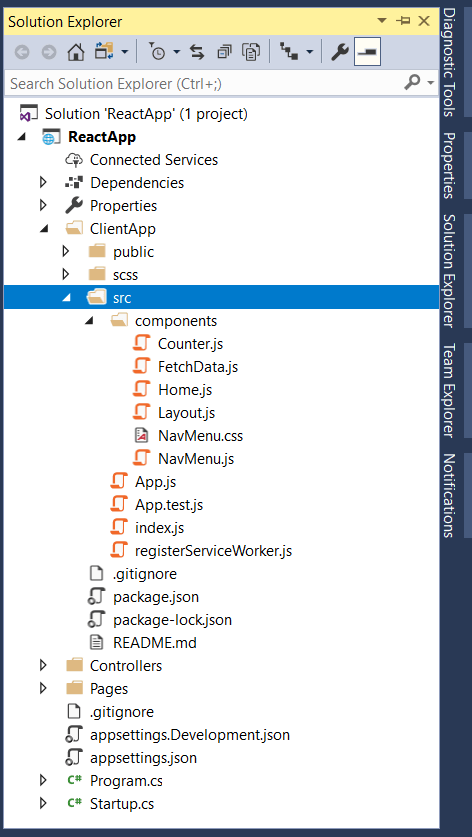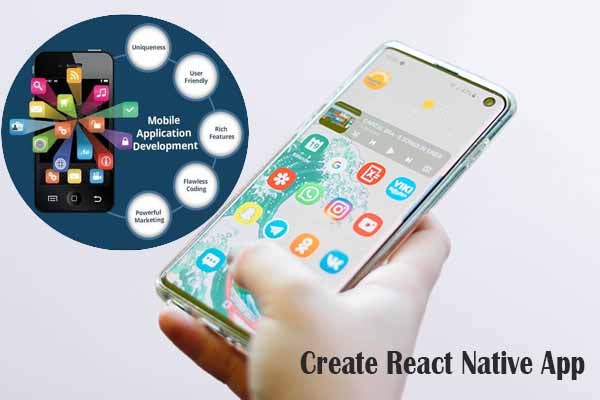In this post, we are going to create an Create React App application, then add configuration to debug it in Visual Studio Code.
- Xamarin and React Native are two of the most popular cross-platform frameworks for developing mobile applications. A vast community of developers, shorter development cycles, cost efficiency, ease of coding for multiple platforms are just a few of the reasons why both these frameworks will dominate the mobile app development market in 2019.
- Visual Studio Code (or Atom.) Node and NPM. Npminstall -g react-native-cli. Xcode (if you’re working on a Mac) Android Studio. Dev npm packages. Npm install eslinteslint-plugin-import eslint-plugin-jsx-a11y babel-eslinteslint-config-airbnbeslint-plugin-react eslint-plugin-react-native -save. VS Code plugins – F1 - ext install.
- React Native - Visual Studio Marketplace This extension targets a platform (React Native) that is rapidly evolving and therefore is currently in early preview. It has been designed for use with React Native 0.19.0 and above.
Table of Contents
Check out Learn Visual Studio Code to learn everything you need to know about about the hottest editor in Web Development for only $10!

React Native commands in the Command Palette In the Command Palette, type React Native and choose a command. The Run Android command triggers react-native run-android and starts your app for Android. The Run iOS command similarly triggers react-native run-ios and starts your app in the iOS simulator (e.g. These search paths are defined in 'C:Program Files (x86)Microsoft Visual Studio2019BuildToolsMSBuildCurrentbinmsbuild.exe.Config'. Confirm that the path in the declaration is correct, and that the file exists on disk in one of the search paths.
TLDR - For an Create React App application, install the Debugger for Chrome extension, create a debug configuration in VS Code, and then run in debug mode.
Learn VS Code
If you're interested in learning more about VS Code, you definitely want to check out the upcoming Learn VS Code course.
Creating a Starter Project
To be able to test an Create React App application, you need an Create React App application :) I'll provide the basic steps, but for more reference on how to get started look at the Create React App page.
First, you'll need to install the Create React App.
BeginnerTailwind.comLearn Tailwind CSS from Scratchnpm install -g create-react-app
After that finishes, you'll need to actually generate your new application. This will take a bit as it needs to install LOTS of NPM packages.
create-react-app my-app
Open the project in VS Code and you should see the following.
Now, that you've got your new fancy React app, go ahead and run it to make sure everything looks right.
npm start
Should look like this.
Creating Debug Configuration
Assuming you've made it this far, we are ready to start debugging! Before we do, however, it's worth understanding how configuring debugging in VS Code works. Basically debug configurations are saved in a launch.json file which is stored inside of a .vscode folder. This .vscode folder is used to store different configurations for Code including our required debugging stuff.
Before you create your debug configuration, you need to install the Debugger for Chrome extension. Find and install this extension from the extension tab in VS Code. After installing, reload VS Code.
Now, to create a debug configuration, you can open the debug panel (the bug looking button on the left panel). At the top of the debug panel, you should see a dropdown that says 'No Configurations'.
To the right of that dropdown, there is a gear icon. Click this button to have VS Code automatically generate that .vscode folder and launch.json file mentioned above.
Then choose Chrome.
You should get the following configuration created for you.
The only thing we need to do is update the port from 8080 to 3000.
Let's Debug
Now we're ready! Go ahead and click the play button at the top of the Debug panel which will launch an instance of Chrome in debug mode. Keep in mind your app should already be running from using ng serve earlier. In VS Code, you should see the Debug toolbar pop up.
With this up and running, you can set a breakpoint in your App.js. Open up your App.js and add a breakpoint inside of the render function by clicking in the gutter (to the left of the line numbers). Should look like this.
Now, refresh debugging by clicking the refresh button on the debugging toolbar. This should open your application again and trigger this breakpoin. You should be directed back to VS Code directly to the place where you set your breakpoint.

From here, you can set more breakpoints, inspect variables, etc. If you are interested in learning more about debugging JavaScript in general in either Chrome or VS Code you can check out Debugging JavaScript in Chrome and Visual Studio Code.
Again, if you're interested in learning more about VS Code, you'll definitely want to check out the upcoming Learn VS Code course.
If you have any follow up questions or comments, leave one below of find me on twitter @jamesqquick.
For video content, check out my YouTube Channel
Like this article? Follow @jamesqquick on Twitter
Read next..
The App Center SDK uses a modular architecture so you can use any or all of the services.
Let's get started with setting up App Center React Native SDK in your app to use App Center Analytics and App Center Crashes.
1. Prerequisites
Before you begin, make sure that the following prerequisites are met:
- You're using a React Native project that runs React Native 0.34 or later.
- You're targeting devices that are running on Android Version 5.0/API level 21 or later, or iOS version 9.0 or later.
- You're not using any other library that provides Crash Reporting functionality on iOS.
- For iOS, the default way to use the SDK requires CocoaPods. (If you haven't installed CocoaPods, follow the CocoaPods Getting Started to do so). Nonetheless, it's possible to link the SDK manually.
2. Create your app in the App Center Portal to obtain the App Secret
If you've already created your app in the App Center portal, you can skip this step.
- Head over to appcenter.ms.
- Sign up or log in and hit the blue button on the top right corner of the portal that says Add new and select Add new app from the dropdown menu.
- Enter a name and an optional description for your app.
- Select the appropriate OS (Android or iOS) and select React Native as the platform.
- Hit the button at the bottom right that says Add new app.
Once you've created an app, you can obtain its App Secret on the Settings page on the App Center Portal. At the top right hand corner of the Settings page, click on the triple vertical dots and select Copy app secret to get your App Secret.
3. Add the App Center SDK modules
The default integration of the SDK uses CocoaPods for iOS. If you're not using CocoaPods in your app, you need to integrate the React Native SDK manually for your iOS app.
Open a Terminal and navigate to the root of your React Native project, then enter the following line to add App Center Analytics and Crashes to the app:
Pentax digital camera utility 5 download mac. In case you prefer yarn over npm, use the following command to install App Center:
The App Center SDK uses a modular approach, where you just add the modules for App Center services that you want to use. appcenter-analytics and appcenter-crashes make sense to add to almost every app, as they provide value with no additional setup required. appcenter provides general purpose App Center APIs, useful for multiple services.
3.1 Integrate the SDK automatically for React Native 0.60
3.1.1 Integrate React Native iOS
Run
pod install --repo-updatefrom iOS directory to install CocoaPods dependencies.Create a new file with the name
AppCenter-Config.plistwith the following content and replace{APP_SECRET_VALUE}with your app secret value. Don't forget to add this file to the Xcode project (right-click the app in Xcode and click Add files to ..).Modify the app's AppDelegate.m file to include code for starting SDK:
- Add these lines to import section above the
#if DEBUGor#ifdef FB_SONARKIT_ENABLEDdeclaration (if present):
- Add these lines to the
didFinishLaunchingWithOptionsmethod
- Add these lines to import section above the
3.1.2 Integrate React Native Android

Create a new file with the name appcenter-config.json in
android/app/src/main/assets/with the following content and replace{APP_SECRET_VALUE}with your app secret value.
Note: If the folder named assets doesn't exist, it should be created under 'project_root/android/app/src/main/assets'
Modify the app's res/values/strings.xml to include the following lines:
3.2 Integrate the SDK automatically for React Native lower than 0.60
Note
If you have your React modules linked using relative path inside your Podfile but not referenced in the project, the linking script will fail because it links App Center using static pod versions. You either must follow the steps from the React Native troubleshooting section if you've already run the linking script, or link it yourself
Link the plugins to the React Native app by using the react-native link command.
For iOS, it will try to download the App Center SDK for iOS and macOS from CocoaPods, if you see an error like:
Run the following command:
And then retry running
react-native link.Note
App Center SDK doesn't set up mocks automatically for App Center modules during the linking process. If you're using Jest test framework in your application and experience errors caused by the App Center SDK while running tests with Jest, add the following to the jest section of package.json file (include only modules in use):
Note
Whether processing of crashes is automatic or triggered by Javascript methods, crashes are always processed after the restart of the application. Crashes can't be processed at the time the application crashes.
Edit the project's
android/app/src/main/assets/appcenter-config.jsonand replace theYOUR_APP_SECRETplaceholder value with your App Center project's application secret.Edit the project's
ios/{YourAppName}/AppCenter-Config.plistfile, and replace theYOUR_APP_SECRETplaceholder value with your App Center project's application secret. If AppCenter-Config.plist already exists but not part of your Xcode project, you must add it to the Xcode project manually (right-click the app in XCode and click Add files to ..).
3.3 [iOS only] Integrate the SDK manually for React Native without react-native link or CocoaPods
Do this integration, if you don't want to use CocoaPods.We strongly recommend integrating the SDK via CocoaPods as described above. Nonetheless, it's also possible to integrate the iOS native SDK manually.
Note
The latest App Center React Native SDK doesn't necessarily depend on the latest App Center iOS SDK, because the iOS SDK is updated and released before the React Native one.
The consequence is that you must know which version of the iOS SDK the React Native SDK depends on.
Download the App Center SDK for React Native frameworks provided as a zip file and unzip it.
You'll see a folder named AppCenterReactNativeShared which contains a single framework for the required React Native iOS bridge.
Download the corresponding App Center SDK for iOS frameworks provided as a zip file and unzip it.
You'll see a folder called AppCenter-SDK-Apple/iOS that contains different frameworks for each App Center service. The framework called
AppCenteris required in the project as it contains code that's shared between the different modules.[Optional] Create a subdirectory for 3rd-party libraries.
- As a best practice, 3rd-party libraries usually reside inside a subdirectory (it's often called Vendor), so if you don't have your project organized with a subdirectory for libraries, create a Vendor subdirectory now (under the ios directory of your project).
- Create a group called Vendor inside your Xcode project to mimic your file structure on disk.
Open Finder and copy the previously unzipped AppCenter-SDK-Apple/iOS and AppCenterReactNativeShared folders into your project's folder at the location where you want it to reside.
Add the SDK frameworks to the project in Xcode:
- Make sure the Project Navigator is visible (⌘+1).
- Drag and drop the AppCenter.framework, AppCenterAnalytics.framework, AppCenterCrashes.framework and AppCenterReactNativeShared.framework files from the Finder (in the location from the previous step) into Xcode's Project Navigator. The AppCenter.framework and AppCenterReactNativeShared.framework files are required to start the SDK, make sure they're added to your project, otherwise the other modules won't work and your app won't compile.
- A dialog will appear, make sure your app target is checked, then click Finish.
Link AppCenter React Native plugins projects to your app's project:
Make sure the Project Navigator is visible (⌘+1).
For each AppCenter React Native plugin navigate to the folder containing source code. Paths respectively will be
/node_modules/appcenter/ios/node_modules/appcenter-analytics/ios/node_modules/appcenter-crashes/ios/node_modules/appcenter-push/ios
Drag and drop
.xcodeprojfiles from the Finder into Xcode's Project Navigator. Typically under Libraries group.
Link libraries for AppCenter React Native plugins.Open your project settings and under General tab in the Linked Frameworks and Libraries section add new items referencing target libraries added on the previous step:
libAppCenterReactNative.alibAppCenterReactNativeAnalytics.alibAppCenterReactNativeCrashes.alibAppCenterReactNativePush.a
Modify Header Search Paths to find headers from the AppCenter React Native plugins projects.Open your project settings and under Build Settings tab in the Header Search Paths section add new locations for header files:
$(SRCROOT)/./node_modules/appcenter/ios/AppCenterReactNative$(SRCROOT)/./node_modules/appcenter-analytics/ios/AppCenterReactNativeAnalytics$(SRCROOT)/./node_modules/appcenter-crashes/ios/AppCenterReactNativeCrashes$(SRCROOT)/./node_modules/appcenter-push/ios/AppCenterReactNativePush
Modify the app's AppDelegate.m file to include code for starting SDK:
- Add these lines to import section above the
#if DEBUGor#ifdef FB_SONARKIT_ENABLEDdeclaration (if present):
- Add these lines to the
didFinishLaunchingWithOptionsmethod
- Add these lines to import section above the
Terminal services windows 10 pro. Create new file with the name
AppCenter-Config.plistwith the following content and replace{APP_SECRET_VALUE}with your app secret value. Don't forget to add this file to the XCode project (right-click the app in XCode and click Add files to ..).
Note
The next two steps are only for the apps that use React Native 0.60 and above.
Disable autolinking for React Native 0.60 and above:
- Inside the node_modules folder in each App Center package open react-native.config.js and set
dependency.platforms.iostonull:
- Inside the node_modules folder in each App Center package open react-native.config.js and set
Modify Header Search Paths to find React Native headers from the App Center React Native plugins projects:
- Make sure the Project Navigator is visible (⌘+1).
- For each AppCenter React Native plugins project that you've added to the Libraries group in step 8:
- Select the project and under Build Settings tab in the Header Search Paths section add new locations for header files with a
recursiveoption:${SRCROOT}/./././ios/Pods/Headers
- Select the project and under Build Settings tab in the Header Search Paths section add new locations for header files with a
3.4 [Android only] Integrate the SDK manually for React Native lower than 0.60 without react-native link
Integration steps without the react-native link command.
Open android/settings.gradle file and insert the following lines. Include the dependencies that you want in your project. Each SDK module needs to be added as a separate dependency in this section. If you want to use App Center Analytics and Crashes, add the following lines:
Note
Due to termination of jCenter support all our assemblies were moved to the Maven Central repository. Please follow this guide about migration from jCenter to Maven Central.
Open the project's app level build.gradle file (
android/app/build.gradle) and add the following lines intodependenciessection:Modify the app's MainApplication.java file to include code for starting SDK:
- Add these lines to the import section
- Add AppCenter packages to the
List<ReactPackage> getPackages()method
Open strings.xml file (
android/app/src/main/res/values) and add the following lines inside<resources></resources>tags:Create a new file with the name appcenter-config.json in
android/app/src/main/assets/with the following content and replaceAPP_SECRET_VALUEwith your app secret value.
3.5 If you use auto-backup to avoid getting incorrect information about device, follow the next steps:
Note
Apps that target Android 6.0 (API level 23) or higher have Auto Backup automatically enabled.
Note
If you already have a custom file with backup rule, switch to the third step.
a. Create appcenter_backup_rule.xml file in the android/app/src/main/res/xml folder.

b. Open the project's AndroidManifest.xml file. Add the android:fullBackupContent attribute to the <application> element. It should point to the appcenter_backup_rule.xml resource file.
c. Add the following backup rules to the appcenter_backup_rule.xml file:

4. Start the SDK
Now you can build and launch your application either from command line or Xcode/Android Studio.
4.1 Build and run your application from command line
You may build and launch your iOS application by the following command:
Tip
You can launch it on an iOS simulator or iOS device by specifying the iOS device name in react-native run-ios --device 'myDeviceName'.
You may build and launch your Android application by the following command:
Tip
You can launch it on an android emulator or android device by specifying the device id in react-native run-android --deviceId 'myDeviceId' (deviceId from adb devices command).
4.2 Build and run your application from Xcode or Android Studio
For iOS, open your project's ios/{appname}.xcworkspace or ios/{appname}.xcodeproj file in Xcode and build from there.
React Native Visual Studio 2019 Free
Note
If you linked App Center automatically via react-native link (as in step 3.1), you should open the project's ios/{appname}.xcworkspace file in Xcode. Because App Center CocoaPods dependencies only works with xcworkspace not xcodeproj, and the ios/{appname}.xcodeproj file won't have App Center CocoaPods dependencies linked.
React Native Windows Visual Studio 2019
For Android, import your android project in Android Studio and build from there.
React Native Vscode
You're all set to visualize Analytics and Crashes data on the portal that the SDK collects automatically. There's no additional setup required. Look at Analytics and Crashes section for APIs guides and walkthroughs to learn what App Center can do.
